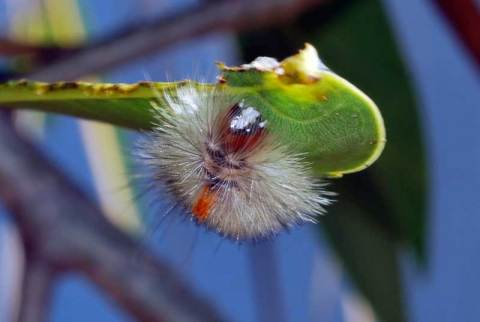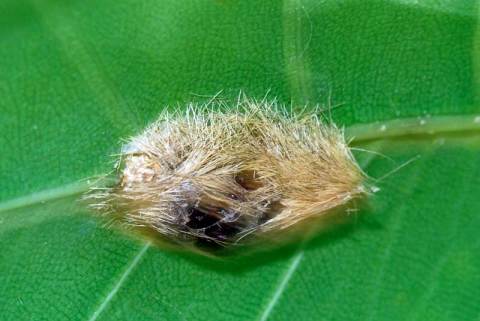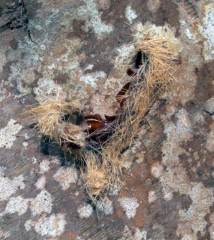Ever since we moved to the new house, I’ve occasionally seen a little blue-bodied moth flying around my back yard, trying to get through the large French doors, but it’s never stuck around long enough for me to run grab my camera and get a picture. One researcher noted that the adult form is quite attractive:
The imago is an attractive bluish grey to purplish grey moth with the abdomen blue dorsally and white ventrally.
I must admit, though, that if you read the rest of the description of the moth, you’ll wonder why I’m unable to get a picture of it. That same author, Genung, notes that “The moths are sluggish and can be captured by hand.” (Maybe they were sluggish in the 50s, but not today!)
They look for all the world (at a glance, rather than on detailed examination) like the moth version of the famous Atala blue butterfly that has undergone such enormous range re-expansion recently thanks to all the native plantings of coontie in the past few decades. (Yay, native plant society!) But it’s very much a moth, not a butterfly. It has feathered antennae, it seems to be more evident in the crepuscular hours rather than broad daylight, and it just seems more elusive than the typical butterfly.
However, if you can find the larvae, you don’t have to worry about them flying away before you can get a shot. Having done a bit of research about this moth, I discovered that the larvae feed on fig, not coontie, leaves. The moth is known as Edwards’ wasp moth, Lymire edwardsii, and it’s something of a pest on the fig plants that are its larval host food. I was home tending a sick baby the other day when I noticed severe leaf damage to the strangler fig that’s making a run at the ancient sabal palmetto in the backyard.
I went over to investigate and found this “wooly” caterpillar crawling on a half-chewed leaf:
Isn’t this just the cutest little face you’ve ever seen?
A bit of poking around, and I found a few more, including one that looked like it was pupating (it seemed to have shed its “wool coat” and to be using it as its protective covering during its transformation):
A few days later I checked back to see what had happened and couldn’t find that pupa, so I widened my search and found this eclosed pupal case on one of the “boots” of the palmetto:
Woolies are in the Arctiidae, the tiger, lichen, and wasp moth family; the famous “wooly bear” caterpillar (Pyrrharctia isabella), the length of whose coat is supposed to be able to predict the severity of the winter, is a member of this group, as is the equally well-known fall webworm moth (Hyphantria cunea).
These little “Rubber tree caterpillars,” as L. edwardsii are also known, can be quite abundant too (as they’d have to be to rise to the level of pest species). Last year, as I was leading my traditional Saturday-after-Thanksgiving bird walk at Green Cay, members of my group noticed dozens of them crawling along the railing in one of the hardwood hammock sections; I wasn’t sure what they were until I started researching this post, but I’m pretty sure it’s the same species: it has what seems like a unique identifying feature, a sort of “collar” sticking up out of the back of its “neck.” It almost looks like a parasitoid protruding out the dorsal surface, but it’s not. The UF “Featured Creatures” page describing this species characterizes this protuberance as
a mid-dorsal tuft of brown setae on the first abdominal segment
which is certainly accurate. For some reason, that same article mentions the distinct color of the face of the caterpillar as its distinguishing feature, rather than this tuft of setae, which to me seems more prominent. But perhaps that little “dagger in the neck” is not as diagnostic as it would seem?
Fortunately for my strangler fig, “real” daggers aren’t uncommon for this species either. Parasitization of this moth larva is apparently quite extensive; one researcher found that up to 96% of larvae in one study were parasitized by tachinid flies and chalcid wasps; another researcher found heavy predation by stink bugs.
This taxon was assigned to the genus Lymire by Walker in 1854 (List of the specimens of Lepidopterous insects in the … British Museum, 1844-1848); the generic name honors Ireland, while the specific name edwardsii honors someone named Edwards. I’m not sure who.
My fig seems to be recovering from the trauma.




